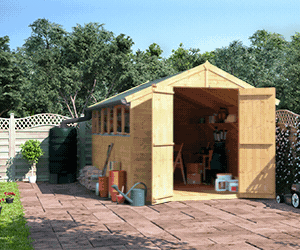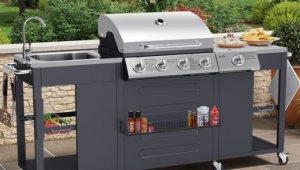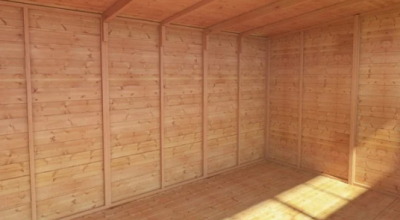Jump to:
You can’t miss chimineas on the list when talking about outdoor heating options. This guide to ‘what is a chiminea’ explains how it works, what it’s made from, and how it differs from a fire pit. Read on to see if your patio needs one!
What Is a Chiminea?

A chiminea is a freestanding outdoor heater shaped like a pot with a tall chimney. It’s been around for centuries and was originally used in Mexico for heating and cooking.
The traditional version was made from terracotta clay. It was shaped with a wide belly for the fire and a narrow flue to direct smoke upwards. That design is still popular, but today you’ll find chimineas made from cast iron, steel, or aluminium. These are more durable, with better heat retention, and are less fragile than clay.
Chimineas might’ve started as tools for cooking and heating, but these days, they’re mainly used to warm up outdoor spaces. Thanks to their compact shape and materials, they’re easy to work into most garden setups.
What Are Chimineas Made Of?
As mentioned earlier, chimineas come in a few different materials, including:
Clay
Clay chimineas have that classic, rustic look and are often hand-finished, but also the most delicate. Sudden temperature changes (like lighting a fire in cold weather) can cause cracks.
If you’re going for this, it’s best to use a layer of sand at the base and let the fire build up gradually. You’ll also want to keep it covered when not in use, especially in winter, to avoid moisture soaking into the clay.
Cast iron
Cast iron chimineas hold onto heat for longer, which means they stay warm even after the fire dies down. On the flip side, they’re heavy and will rust if left exposed to rain. A weatherproof cover and occasional recoating with fire-safe paint or oil can help.
Steel
Steel chimineas are the lightest of the three, which makes them easier to move around. They’re often more modern, with sleek finishes that suit contemporary patios. They don’t hold heat as long as cast iron, but they’re quick to cool down and generally easier to look after.
One example is this metal chiminea featuring a sleek metallic design. It also has a safe and atmospheric mesh covering (see-through) and a poker for stoking the fire.
The Difference Between Chimnea and Fire Pit
A chiminea has an enclosed body with a chimney on top. This design directs heat forward and smoke upward. In contrast, a fire pit is open on all sides, usually round or square, with no chimney or cover.
When it comes to smoke control, chimineas are better thanks to the chimney. It vents straight up, helping to avoid smoke blowing across seating areas. Fire pits don’t manage this as well, especially in windy spots.
Now, for heat direction: chimineas give off heat from the front only. That will do if you’re using it against a wall or in a corner. Fire pits throw out heat all around, so they’re better for groups sitting in a circle.
The flame in a chiminea is contained inside the body. This, in turn, adds a layer of safety, particularly if you have kids or pets around. A fire pit, with its open flame, looks great but needs more supervision.
For fuel efficiency, chimineas burn slower and tend to use less fuel. Fire pits go through more wood but give you that open-fire experience.
Is a Chiminea for You?
A chiminea might suit you if you have a smaller patio or a garden corner that could use some warmth. It takes up less space than a fire pit and doesn’t smoke the entire area. It’s great for low-key evenings too. Once it’s lit, it stays warm without much effort.
But if you plan to gather friends around the fire, a fire pit might do the job better. Chimineas give off heat in one direction, not all sides.
Want to see what might work in your garden? Browse our fire pits for gardens + chimineas for options.
Shop ChimineasFAQs
What is a chiminea, and how is it used?
Chimineas originated from Mexico and have been used for outdoor heating and cooking for centuries. In essence, this central heating source is a portable, decorative outdoor fireplace.
Where to put a chiminea?
The best place is somewhere permanent and outdoor with a flat surface such as a patio. Chimineas tend to be heavy, so you'll not want to have to move them around often.
How to set up cast iron chimineas?
Make sure to place it on a flat, solid, level base - somewhere without any danger of toppling over. Some models require assembly, so be careful to follow the instructions and keep them for future repairs or maintenance.
How to set up clay chimineas?
Like cast-iron chimineas, set it up on a flat, solid, level surface with no danger of it toppling over. Make sure the entire base is supported to avoid uneven pressure that may cause cracking.
How do I repair cracks in my clay chiminea?
Clean the cracks properly by brushing them out and removing loose clay pieces. Then, sand the outside of the cracked area using medium-grit sandpaper. Remove all old sealants or paint.
Ensure the material you're using to fill in the crack will properly adhere to the surface.
How to maintain a chiminea?
Generally, to ensure your chiminea will give you years of warmth and satisfaction, provide it with regular upkeep. A cover can be purchased to protect the model from rain, ice, snow, and the blistering sun.
Also, be sure to cover the bottom with at least 3 inches of sand to protect it from cracking.













What do you think ?